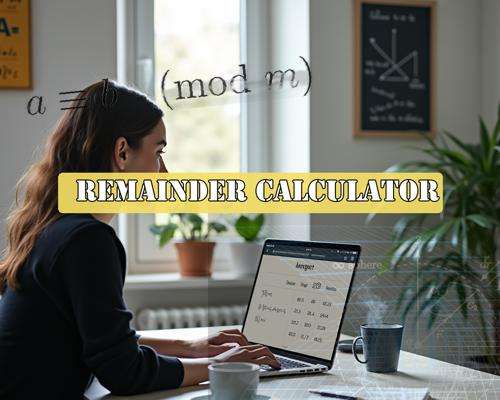More on this this Remainder Calculator
Use this tool to find the remainder for the quotient of two numbers. This is also known as the modulo operation
for two given integers.
Once you provide a valid dividend and divisor, just click on the
"Calculate"
button to get the work shown and the result provided to you.
What is a Remainder Calculator?
A remainder calculator is an online tool designed to help you find the remainder when one number is divided by another.
This kind of tool is particularly useful for educational purposes, where understanding the concept of remainders can play a vert important role in mathematical theory, as well as for practical
applications in various fields like programming, finance, and engineering.
How to Use this Remainder Calculator
The steps for using this calculator are very simple, and here is how you can do it:
- Enter the dividend (the number to be divided).
- Enter the divisor (the number you are dividing by).
- Click on the 'Calculate' button to get the quotient and remainder.

Dividend, Divisor, Quotient, and Remainder
It is crucial to understand the elements involving when doing a division. Indeed, when you divide one number by another, you get:
- Dividend: The number being divided.
- Divisor: The number you are dividing by.
- Quotient: The result of the division, which is how many times the divisor fits into the dividend.
- Remainder: What is left over after the division. It need to ALWAYS be less than the divisor.
The relationship can be expressed as: \( \text{Dividend} = (\text{Divisor} \times \text{Quotient}) + \text{Remainder} \).
How to do Long Division with Remainders
- Set up the division problem with the dividend inside the bracket and the divisor outside.
- Determine how many times the divisor goes into the first digit or digits of the dividend.
- Write the quotient above the line, then multiply this number by the divisor.
- Subtract this product from the digits of the dividend you used.
- Bring down the next digit of the dividend and repeat the process until you have no more digits to bring down.
- The final number left is the remainder.

Remainder Trick for Quick Calculations
Here are some tricks to quickly calculate remainders:
- Modulo by 10: The remainder when dividing by 10 is simply the last digit of the number.
- Modulo by 5: If the number ends in 0 or 5, the remainder is 0 or 5 respectively. Otherwise, it's the same as the last digit.
- Modulo by 2: If the number is even, the remainder is 0; if odd, it's 1.
How to Interpret the Remainder in Real-Life Scenarios
Like much of the Math we learn, remainders have practical applications in real life:
- In time calculations, remainders can represent minutes or seconds.
- In financial calculations, remainders might be cents or fractions of a dollar.
- We used in coding projects, remainders are used in algorithms like hash functions or to cycle through sequences.
Examples of Remainder Calculations
Here are some examples that will help you get a clear idea of how the process goes:
- 833 divided by 64: The quotient is 12, and the remainder is 53. This is because 833 = 64*12 + 53 and 53 < 64.
- 26 divided by 6: The quotient is 4, and the remainder is 2. This is because 26 = 6*4 + 2 and 2 < 6.
- 24 divided by 7: The quotient is 3, and the remainder is 3. This is because 24 = 7*3 + 3 and 3 < 7.
Modulo Operation and Remainders
The modulo operation, often denoted as \( a \mod n \), gives the remainder when \( a \) is divided by \( n \). Here are some key points:
- It is used in cryptography, computer science, and number theory.
- \[ a \mod n = r \text{ where } 0 \leq r < n \]

FAQs on Remainder Calculation
What is the quotient and the remainder?
The quotient is the result of division, showing how many times the divisor fits into the dividend. The remainder is what is left over after this division.
How do you write a remainder as a fraction?
If you have a remainder \( r \) when dividing \( a \) by \( b \), you can express it as a fraction: \( \frac{r}{b} \). For example, if 26 divided by 6 leaves a remainder of 2, you can write it as \( \frac{2}{6} \) or simplify to \( \frac{1}{3} \).
How do you write remainders?
Remainders are typically written as a small number next to the quotient, separated by 'r' or 'mod'. For example, 26 divided by 6 can be written as \( 4 \text{ r } 2 \) or \( 26 \mod 6 = 2 \).
Example: What is the remainder for the following setting: 26 is divided by 6?
The remainder when 26 is divided by 6 is 2.
Example Calculating the remainder of 24 divided by 7?
In order to calculate the remainder of 24 divided by 7 you need to:
- Divide 24 by 7 to get a quotient of 3.
- Multiply 3 by 7 to get 21.
- Subtract 21 from 24 to find the remainder, which is 3.
More Integer Numbers Calculators
If you're diving deeper into the world of division and remainders, you might find our Modulo Calculator particularly useful.
It helps you understand the remainder when one number is divided by another, which is closely related to finding remainders directly.
Additionally, if you're interested in the whole number part of your division, our Quotient Calculator can provide insights into how many times one number fits into another without considering the remainder.
When dealing with more complex division scenarios, our Synthetic Division Calculator can simplify polynomial division, which is a step beyond basic remainders and can be crucial in algebra and calculus. For everyday calculations involving decimals, our Division With Decimals Calculator ensures precision in your results, which might be necessary when remainders involve decimal points.